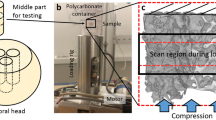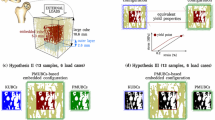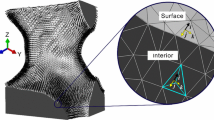Abstract
Linear microcracks and diffuse damage (staining over a broad region) are two types of microscopic damage known to occur in vivo in human vertebral trabecular bone. These damage types might be associated with vertebral failure. Using microcomputed tomography and finite element analysis for specimens of cancellous bone, we estimated the stresses in the trabeculae of human vertebral tissue for inferosuperior loading. Microdamage was quantified histologically. The density of in vivo linear microcracks was, but the diffuse damage area was not, related to the estimates of von Mises stress distribution in the tissue. In vivo linear microcrack density increased with increasing coefficient of variation of the trabecular von Mises stress and with increasing average trabecular von Mises stress generated per superoinferior apparent axial stress. Nonlinear increase in linear crack density, similar to the increase of the coefficient of variation of trabecular shear stresses, with decreasing bone stiffness and bone volume fraction suggests that damage may accumulate rather rapidly in diseases associated with low bone density due to the dramatic increase of shear stresses in the tissue. © 2003 Biomedical Engineering Society.
PAC2003: 8719Rr, 8719Xx, 8759Ls, 8759Fm, 8710+e
Similar content being viewed by others
References
Burr, D. B., M. R. Forwood, D. P. Fyhrie, R. B. Martin, M. B. Schaffler, and C. H. Turner. Bone microdamage and skeletal fragility in osteoporotic and stress fractures. J. Bone Miner. Res.12:6–15, 1997.
Burr, D. B., C. H. Turner, P. Naick, M. R. Forwood, W. Ambrosius, M. S. Hasan, and R. Pidaparti. Does microdamage accumulation affect the mechanical properties of bone. J. Biomech.31:337–345, 1998.
Norman, T. L., Y. N. Yeni, C. U. Brown, and Z. Wang. Influence of microdamage on fracture toughness of the human femur and tibia. Bone23:303–306, 1998.
Hoshaw, S. J., D. D. Cody, A. M. Saad, and D. P. Fyhrie. Decrease in canine proximal femoral ultimate strength and stiffness due to fatigue damage. J. Biomech.30:323–329, 1997.
Boyce, T. M., D. P. Fyhrie, M. C. Glotkowski, E. L. Radin, and M. B. Schaffler. Damage type and strain mode associations in human compact bone bending fatigue. J. Orthop. Res.16:322–329, 1998.
Burr, D. B., R. B. Martin, M. B. Schaffler, and E. L. Radin. Bone remodeling in response to fatigue microdamage. J. Biomech.18:189–200, 1985.
Verborgt, O., G. J. Gibson, and M. B. Schaffler. Loss of osteocyte integrity in association with microdamage and bone remodeling after fatigue. J. Bone Miner. Res.15:60–67, 2000.
Martin, B.Mathematical model for repair of fatigue damage and stress fracture in osteonal bone. J. Orthop. Res.13:309–316, 1995.
Frost, H. M.Presence of microscopic cracks in bone. Henry Ford Hosp. Bull.8:25–35, 1960.
Fazzalari, N. L., M. R. Forwood, B. A. Manthey, K. Smith, and P. Kolesik. Three-dimensional confocal images of microdamage in cancellous bone. Bone23:373–378, 1998.
Bentolila, V., T. M. Boyce, D. P. Fyhrie, R. Drumb, T. M. Skerry, and M. B. Schaffler. Intracortical remodeling in adult rat long bones after fatigue loading. Bone23:275–281, 1998.
Fazzalari, N. L., M. R. Forwood, K. Smith, B. A. Mathey, and P. Herreen. Assessment of cancellous bone quality in severe osteoarthrosis: Bone mineral density, mechanics, and microdamage. Bone22:381–388, 1998.
Zioupos, P.Accumulation of fatigue microdamage and its relation to biomechanical properties in aging human cortical bone. J. Microsc.201:270–278, 2001.
Norman, T., and T. Little. The incidence and role of diffuse damage in human cortical bone. Proceedings of the 48th Annual Meeting, Orthopaedic Research Society, Dallas, TX, 10–13 February 2002, p. 0545.
Parsamian, G. P., and T. L. Norman. Diffuse damage accumulation in the fracture process zone of human cortical bone specimens and its influence on fracture toughness. J. Mater. Sci.: Mater. Med.12:779–783, 2001.
Carter, D. R., and W. C. Hayes. Compact bone fatigue damage. I. Residual strength and stiffness. J. Biomech.10:325–337, 1977.
Keaveny, T. M., E. F. Wachtel, X. E. Guo, and W. C. Hayes. Mechanical behavior of damaged trabecular bone. J. Biomech.27:1309–1318, 1994.
Keaveny, T. M., E. F. Wachtel, and D. L. Kopperdahl. Mechanical behavior of human trabecular bone after overloading. J. Orthop. Res.17:346–353, 1999.
Reilly, G. C., and J. D. Currey. The effects of damage and microcracking on the impact strength of bone. J. Biomech.33:337–343, 2000.
Yeni, Y. N., and D. P. Fyhrie. Fatigue damage-fracture mechanics interaction in cortical bone. Bone30:509–514, 2002.
Fondrk, M., E. Bahniuk, D. T. Davy, and C. Michaels. Some viscoplastic characteristics of bovine and human cortical bone. J. Biomech.21:623–630, 1988.
Jepsen, K. J., and D. T. Davy. Comparison of damage accumulation measures in human cortical bone. J. Biomech.30:891–894, 1997.
Wenzel, T. E., M. B. Schaffler, and D. P. Fyhrie. microcracks in human vertebral trabecular bone. Bone19:89–95, 1996.
Vashishth, D., J. Koontz, S. J. Qiu, D. Lundin-Cannon, Y. N. Yeni, M. B. Schaffler, and D. P. Fyhrie. diffuse damage in human vertebral cancellous bone. Bone26:147–152, 2000.
Fyhrie, D. P., S. J. Hoshaw, M. S. Hamid, and F. J. Hou. Shear stress distribution in the trabeculae of human vertebral bone. Ann. Biomed. Eng.28:1194–1199, 2000.
Fyhrie, D. P., and M. B. Schaffler. Failure mechanisms in human vertebral cancellous bone. Bone15:105–109, 1994.
Moore, T. L. A., and L. J. Gibson. Microdamage accumulation in bovine trabecular bone in uniaxial compression. J. Biomech. Eng.124:63–71, 2002.
Hou, F. J., S. M. Lang, S. J. Hoshaw, D. A. Reimann, and D. P. Fyhrie. Human vertebral body apparent and hard tissue stiffness. J. Biomech.31:1009–1015, 1998.
Ladd, A. J., J. H. Kinney, D. L. Haupt, and S. A. Goldstein. Finite-element modeling of trabecular bone: Comparison with mechanical testing and determination of tissue modulus. J. Orthop. Res.16:622–628, 1998.
Yeni, Y. N., F. J. Hou, D. Vashishth, and D. P. Fyhrie. Trabecular shear stress in human vertebral cancellous bone: Intra-and interindividual variations. J. Biomech.34:1341–1346, 2001.
Ulrich, D., T. Hildebrand, B. Van Rietbergen, R. Muller, and P. Ruegsegger. The quality of trabecular bone evaluated with micro-computed tomography, fea and mechanical testing. Stud. Health Technol. Inform.40:97–112, 1997.
Bury, K. Statistical Distributions in Engineering. Cambridge, U.K.: Cambridge University Press, 1999.
Malvern, L. E. Introduction to the Mechanics of a Continuous Medium. Englewood Cliffs, NJ: Prentice-Hall, 1969.
Fyhrie, D. P., and D. Vashishth. Bone stiffness predicts strength similarly for human vertebral cancellous bone in compression and for cortical bone in tension. Bone26:169–173, 2000.
Yeni, Y. N., and D. P. Fyhrie. Finite element predicted apparent stiffness is a consistent predictor of apparent strength in human cancellous bone tested with different boundary conditions. J. Biomech.34:1649–1654, 2001.
Yeni, Y. N., and D. P. Fyhrie. Viscoelastic microcrack-bridging can explain the strain rate dependency of cortical bone apparent strength. Proceedings of the 48th Annual Meeting, Orthopaedic Research Society, Dallas, TX, 10–13 February 2002, p. 0018.
Rubin, C. T., and L. E. Lanyon. Regulation of bone mass by mechanical strain magnitude. Calcif. Tissue Int.37:411–417, 1985.
Mosley, J. R., and L. E. Lanyon. Strain rate as a controlling influence on adaptive modeling in response to dynamic loading of the ulna in growing male rats. Bone23:313–318, 1998.
Knothe Tate, M. L., U. Knothe, and P. Niederer. Experimental elucidation of mechanical load-induced fluid flow and its potential role in bone metabolism and functional adaptation. Am. J. Med. Sci.316:189–195, 1998.
Tate, M. L., P. Niederer, and U. Knothe. tracer transport through the lacunocanalicular system of rat bone in an environment devoid of mechanical loading. Bone22:107–117, 1998.
Dodd, J. S., J. A. Raleigh, and T. S. Gross. Osteocyte hypoxia: A novel mechanotransduction pathway. Am. J. Physiol.277:C598–C602, 1999.
Gross, T. S., N. Akeno, T. L. Clemens, S. Komarova, S. Srinivasan, D. A. Weimer, and S. Mayorov. Selected contribution: Osteocytes upregulate hif-1alpha in response to acute disuse and oxygen deprivation. J. Appl. Physiol.90:2514–2519, 2001.
Porter, B. D., R. Zauel, S. H. Cartmell, D. Fyhrie, R. E. Guldberg, and H. W. Stockman. Three-dimensional computational modeling of media flow through scaffolds in a perfusion bioreactor. Proceedings of the 49th Annual Meeting, Orthopaedic Research Society, New Orleans, LA, 2–5 February 2003, p. 0274.
Ciarelli, T. E., D. P. Fyhrie, H. W. Stockman, and R. Zauel. Simulation of pressure driven flow through anatomically accurate canalicular systems of cortical bone. Proceedings of the 49th Annual Meeting, Orthopaedic Research Society, New Orleans, LA, 2–5 February 2003.
Tami, A. E., P. Nasser, O. Verborgt, M. B. Schaffler, and M. L. Knothe Tate. The role of interstitial fluid flow in the remodeling response to fatigue loading. J. Bone Miner. Res.17:2030–2037, 2002.
Choi, K., D. P. Fyhrie, and M. B. Schaffler. Failure mechanisms of compact bone in bending: A microstructural analysis. Proceedings of the 40th Annual Meeting, Orthopaedic Research Society, New Orleans, LA, p. 425.
Charras, G. T., and R. E. Guldberg. Improving the local solution accuracy of large-scale digital image based finite lement analyses. J. Biomech.33:255–259, 2000.
Guldberg, R. E., S. J. Hollister, and G. T. Charras. The accuracy of digital image-based finite element models. J. Biomech. Eng.120:289–295, 1998.
Niebur, G. L., J. C. Yuen, A. C. Hsia, and T. M. Keaveny. Convergence behavior of high-resolution finite element models of trabecular bone. J. Biomech. Eng.121:629–635, 1999.
van Rietbergen, B., H. Weinans, R. Huiskes, and A. Odgaard. A new method to determine trabecular bone elastic properties and loading using micromechanical finite-element models. J. Biomech.28:69–81, 1995.
Jacobs, C. R., B. R. Davis, C. J. Rieger, J. J. Francis, M. Saad, and D. P. Fyhrie. Nacob presentation to asb young scientist award: Postdoctoral. The impact of boundary conditions and mesh size on the accuracy of cancellous bone tissue modulus determination using large-scale finite-element modeling. North American congress on biomechanics. J. Biomech.32:1159–1164, 1999.
Author information
Authors and Affiliations
Rights and permissions
About this article
Cite this article
Yeni, Y.N., Hou, F.J., Ciarelli, T. et al. Trabecular Shear Stresses Predict In Vivo Linear Microcrack Density but not Diffuse Damage in Human Vertebral Cancellous Bone. Annals of Biomedical Engineering 31, 726–732 (2003). https://doi.org/10.1114/1.1569264
Issue Date:
DOI: https://doi.org/10.1114/1.1569264




